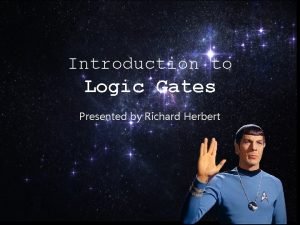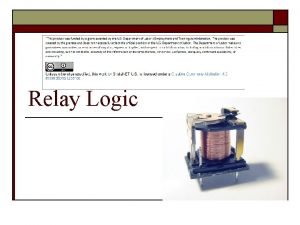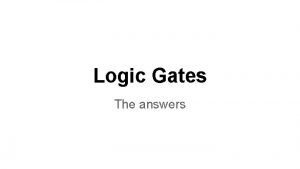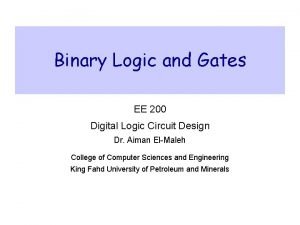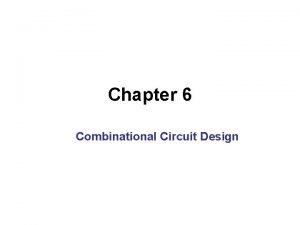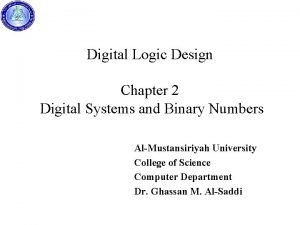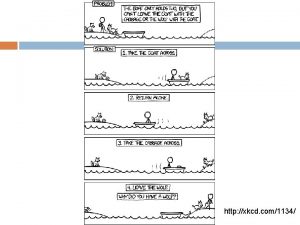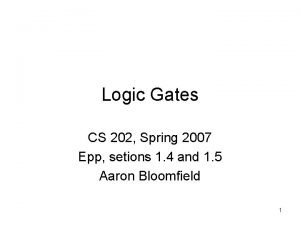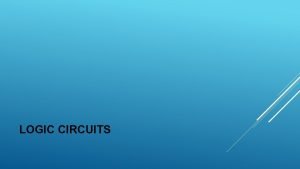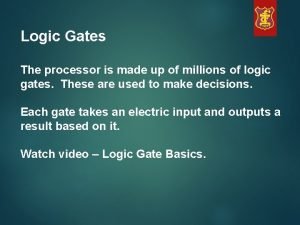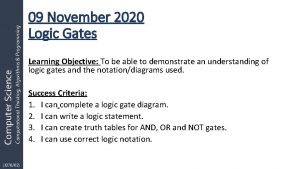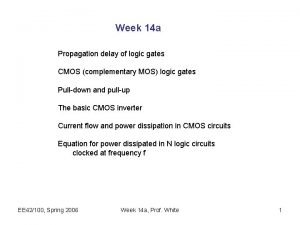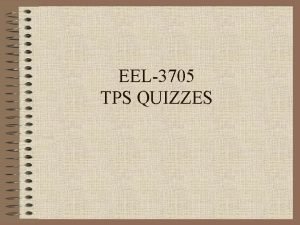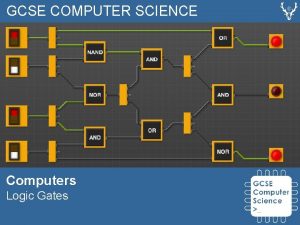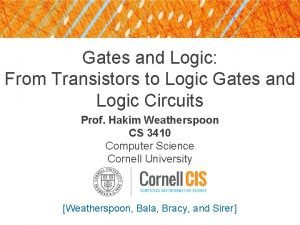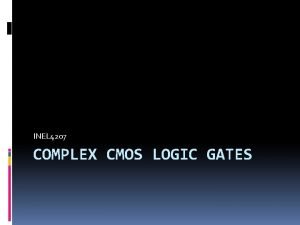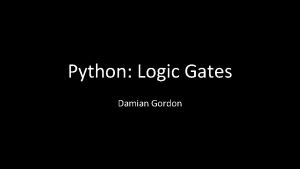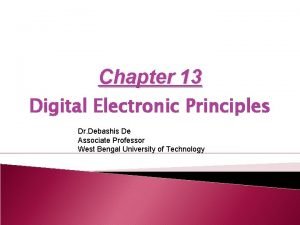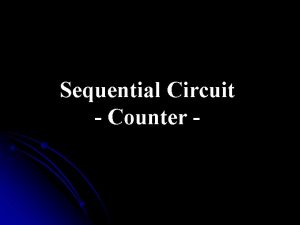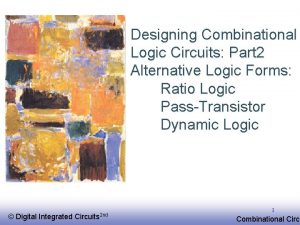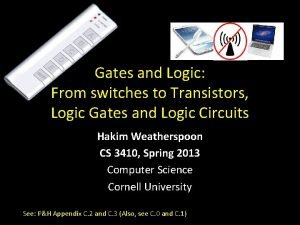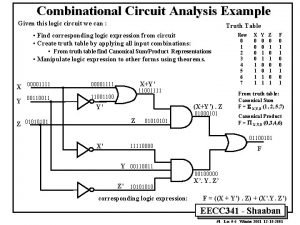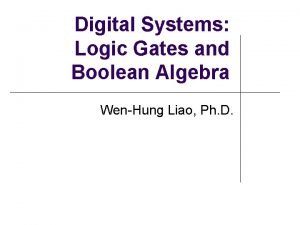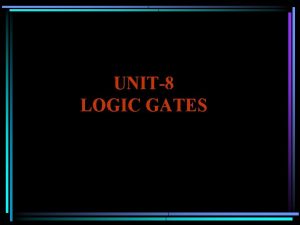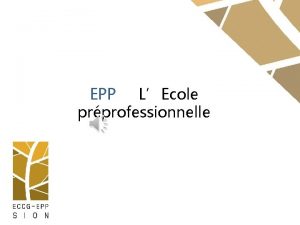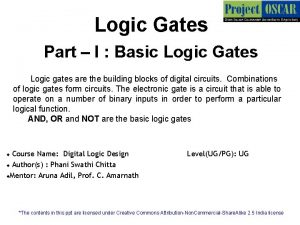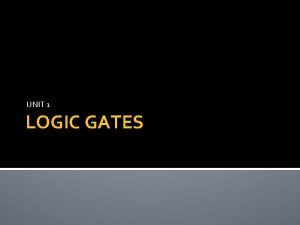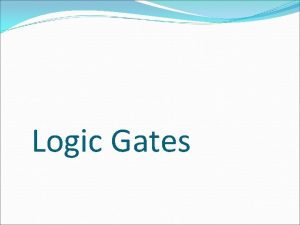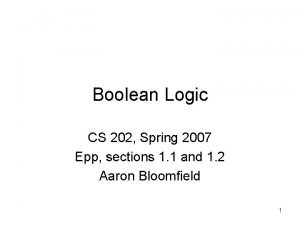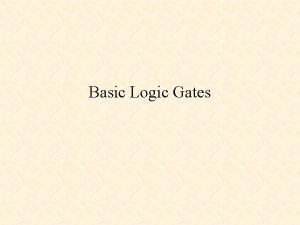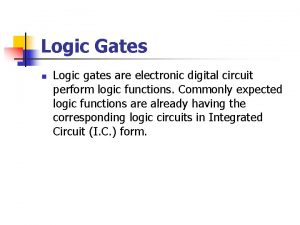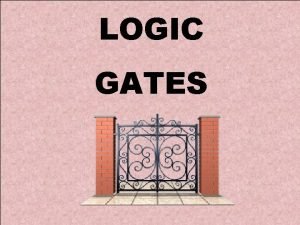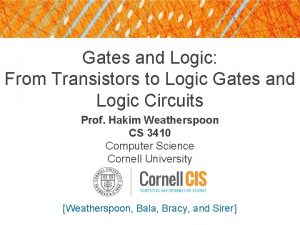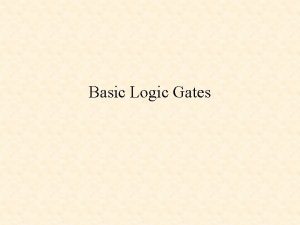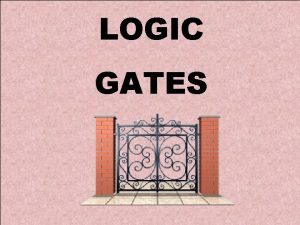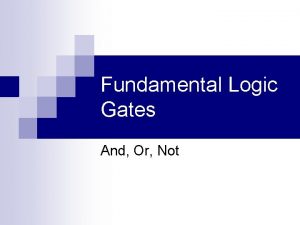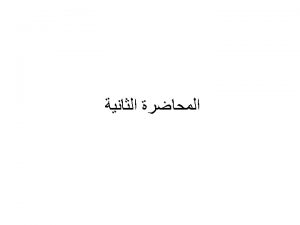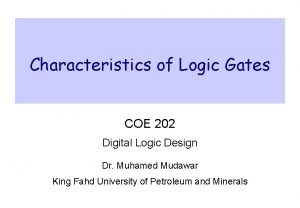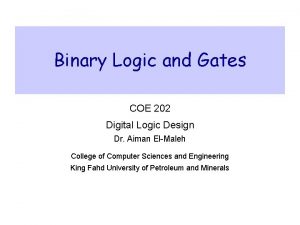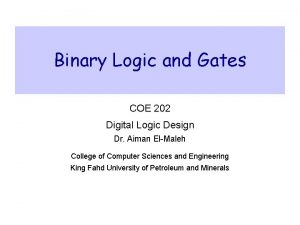Logic Gates CS 202 Spring 2007 Epp setions





























- Slides: 29

Logic Gates CS 202, Spring 2007 Epp, setions 1. 4 and 1. 5 Aaron Bloomfield 1

Review of Boolean algebra • Just like Boolean logic • Variables can only be 1 or 0 – Instead of true / false 2

Review of Boolean algebra • Not_ is a horizontal bar above the number – 0_ = 1 – 1=0 • Or is a plus – – 0+0 = 0 0+1 = 1 1+0 = 1 1+1 = 1 • And is multiplication – – 0*0 = 0 0*1 = 0 1*0 = 0 1*1 = 1 3

Review of Boolean algebra ___ • Example: translate (x+y+z)(xyz) to a Boolean logic expression – (x y z) ( x y z) • We can define a Boolean function: – F(x, y) = (x y) ( x y) • And then write a “truth table” for it: x y F(x, y) 1 1 0 0 0 1 0 0 4

Basic logic gates • Not • And • Or • Nand • Nor • Xor 5

Converting between circuits and equations • Find the output of the following circuit x+y (x+y)y y __ • Answer: (x+y)y – Or (x y) y 6

Converting between circuits and equations • Find the output of the following circuit x xy xy y ___ __ • Answer: xy – Or ( x y) ≡ x y 7

Converting between circuits and equations • Write the circuits for the following Boolean algebraic expressions __ a) x+y x x+y 8

Converting between circuits and equations • Write the circuits for the following Boolean algebraic expressions _______ b) (x+y)x x+y (x+y)x 9

Writing xor using and/or/not • p q (p q) ¬(p q) ____ • x y (x + y)(xy) x+y xy x y 1 1 0 1 0 1 1 0 0 0 (x+y)(xy) xy 10

Converting decimal numbers to binary • 53 = 32 + 16 + 4 + 1 = 25 + 2 4 + 2 2 + 2 0 = 1*25 + 1*24 + 0*23 + 1*22 + 0*21 + 1*20 = 110101 in binary = 00110101 as a full byte in binary • 211= 128 + 64 + 16 + 2 + 1 = 27 + 2 6 + 2 4 + 2 1 + 2 0 = 1*27 + 1*26 + 0*25 + 1*24 + 0*23 + 0*22 + 1*21 + 1*20 = 11010011 in binary 11

Converting binary numbers to decimal • What is 10011010 in decimal? 10011010 = 1*27 + 0*26 + 0*25 + 1*24 + 1*23 + 0*22 + 1*21 + 0*20 = 2 7 + 24 + 23 + 21 = 128 + 16 + 8 + 2 = 154 • What is 00101001 in decimal? 00101001 = 0*27 + 0*26 + 1*25 + 0*24 + 1*23 + 0*22 + 0*21 + 1*20 = 2 5 + 23 + 20 = 32 + 8 + 1 = 41 12

A note on binary numbers • In this slide set we are only dealing with non-negative numbers • The book (section 1. 5) talks about two’scomplement binary numbers – Positive (and zero) two’s-complement binary numbers is what was presented here – We won’t be getting into negative two’scomplmeent numbers 13

How to add binary numbers • Consider adding two 1 -bit binary numbers x and y – – 0+0 = 0 0+1 = 1 1+0 = 1 1+1 = 10 x 0 0 1 1 y 0 1 Carry Sum 0 0 0 1 1 0 • Carry is x AND y • Sum is x XOR y • The circuit to compute this is called a half-adder 15

The half-adder • Sum = x XOR y • Carry = x AND y x y Carry Sum 0 0 0 1 1 0 16

Using half adders • We can then use a half-adder to compute the sum of two Boolean numbers 1 1 +1 ? 0 1 1 0 0 1 0 17

How to fix this • We need to create an adder that can take a carry bit as an additional input – Inputs: x, y, carry in – Outputs: sum, carry out • This is called a full adder – Will add x and y with a half-adder – Will add the sum of that to the carry in • What about the carry out? – It’s 1 if either (or both): – x+y = 10 – x+y = 01 and carry in = 1 x 1 1 1 y 1 1 0 c carry sum 1 1 1 0 1 0 0 0 1 0 0 1 0 18

The full adder • The “HA” boxes are half-adders x 1 1 1 y 1 1 0 c 1 0 1 s 1 0 0 1 carry sum 1 1 1 0 0 0 1 1 0 0 0 1 0 1 1 1 0 0 0 0 1 1 0 s 1 c 1 19

The full adder • The full circuitry of the full adder 20

Adding bigger binary numbers • Just chain full adders together . . . 21

Adding bigger binary numbers • A half adder has 4 logic gates • A full adder has two half adders plus a OR gate – Total of 9 logic gates • To add n bit binary numbers, you need 1 HA and n-1 FAs • To add 32 bit binary numbers, you need 1 HA and 31 FAs – Total of 4+9*31 = 283 logic gates • To add 64 bit binary numbers, you need 1 HA and 63 FAs – Total of 4+9*63 = 571 logic gates 22

More about logic gates • To implement a logic gate in hardware, you use a transistor • Transistors are all enclosed in an “IC”, or integrated circuit • The current Intel Pentium IV processors have 55 million transistors! 23

Flip-flops • Consider the following circuit: • What does it do? 24

Memory • A flip-flop holds a single bit of memory – The bit “flip-flops” between the two NAND gates • In reality, flip-flops are a bit more complicated – Have 5 (or so) logic gates (transistors) per flipflop • Consider a 1 Gb memory chip – 1 Gb = 8, 589, 934, 592 bits of memory – That’s about 43 million transistors! • In reality, those transistors are split into 9 ICs of about 5 million transistors each 25

Hexadecimal • A numerical range from 0 -15 – Where A is 10, B is 11, … and F is 15 • Often written with a ‘ 0 x’ prefix • So 0 x 10 is 10 hex, or 16 – 0 x 100 is 100 hex, or 256 • Binary numbers easily translate: 26

From Think. Geek (http: //www. thinkgeek. com) 27

Also from Think. Geek (http: //www. thinkgeek. com) 28

DEADBEEF • Many IBM machines would fill allocated (but uninitialized) memory with the hexadecimal pattern 0 x. DEADBEEF – Decimal -21524111 – See http: //www. jargon. net/jargonfile/d/DEADBEEF. html • Makes it easier to spot in a debugger 29

Also also from Think. Geek (http: //www. thinkgeek. com) • 0 x. DEAD = 57005 • Now add one to that. . . 30
 Xnor gate minecraft
Xnor gate minecraft Relay or gate
Relay or gate Logic gates
Logic gates Precedence of logic gates
Precedence of logic gates Aoi logic gates
Aoi logic gates Compound gates in vlsi
Compound gates in vlsi Binary code
Binary code Xkcd logic gates
Xkcd logic gates Timing diagram for or gate
Timing diagram for or gate Logic gates
Logic gates Application of logic gates in aircraft
Application of logic gates in aircraft Processor logic gates
Processor logic gates Minecraft redstone gates
Minecraft redstone gates Gdqblmdkgw4 -site:youtube.com
Gdqblmdkgw4 -site:youtube.com How to calculate propagation delay in logic gates
How to calculate propagation delay in logic gates Logic gates truth table quiz
Logic gates truth table quiz Logic gates gcse
Logic gates gcse Which gate
Which gate For complex gate design in cmos or
For complex gate design in cmos or Python logic gate simulator
Python logic gate simulator Characteristics of logic gates
Characteristics of logic gates Parking counter using logic gates
Parking counter using logic gates Alternative logic gates
Alternative logic gates Logic gates and
Logic gates and Combinational logic gates truth tables
Combinational logic gates truth tables Nor gate truth table
Nor gate truth table The heavenly banquet
The heavenly banquet Winter is white spring is green
Winter is white spring is green Spring, summer, fall, winter... and spring (2003)
Spring, summer, fall, winter... and spring (2003) First order logic vs propositional logic
First order logic vs propositional logic
